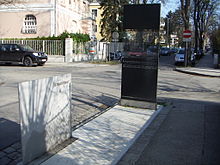Hietzinger Synagogue
The Hietzinger synagogue , and New World synagogue or Hietzinger Temple called, was a club synagogue in the 13th Vienna district , Hietzing . A memorial stele commemorates them.
location
It was located on the corner property Eitelbergergasse 22 / Neue-Welt-Gasse 7 near the border between the districts of Alt-Hietzing and Unter-St.-Veit .
history
Already in 1904 there was a permanent prayer house of the Hietzing Temple Association with 130 seats in Penzinger Straße 132, which was then part of Hietzing (since 1938: 14th district ) . However, since the building was too small, the association intended to move to a larger building. However, due to the outbreak of the First World War, a planned architectural competition did not materialize.
In 1924 an international competition was finally announced. First place went to the architect Arthur Grünberger from old Austria (who emigrated from Vienna to the United States in 1923) in collaboration with Adolf Jelletz in front of a similar design by Hugo Gorge . Third place went to the architect Fritz Landauer with a conservative design. Richard Neutra , who emigrated to the United States in the same year as Grünberger , also provided a draft that was not considered .
Grünberger's plan was finally implemented by Adolf Jelletz from 1926 to 1928, but it was not finalized until 1931. Moses Lewin became rabbi and Salomon Einhorn was chief cantor .
The synagogue was destroyed by arson in the course of the November pogroms in 1938 . The remains were removed in 1939.
architecture
The Hietzing synagogue was the only free-standing synagogue that was built in Vienna between the wars and one of the most important expressionist buildings of that time. The cubic structure with a flat roof was provided with a stylized crenellated wreath, which gave the building a Romanizing appearance and was reminiscent of the fortress synagogues of the 17th century in Podolia and Volhynia .
The shape of the five windows on the main facade above the entrance was a modification of the David shield : the triangle pointing downwards was replaced by a floral shape with three semicircles.
Commemoration
A copper plaque installed after 1945 at Eitelbergergasse 22 reminded of the former synagogue. At the request of a green district politician, a separate memorial was proposed. In 2004, the Hietzing Adult Education Center implemented a clearly visible monument at the corner of Neue-Welt-Gasse 9, called Standpunkt . A plexiglass stele by the artist Hans Kupelwieser shows an image of the destroyed synagogue.
literature
- Pierre Genée: Vienna Synagogues 1825–1938 . Löcker, Vienna 1987, ISBN 3-85409-113-3 , pp. 98f.
- Bob Martens , Herbert Peter: The destroyed synagogues of Vienna. Virtual city walks . Mandelbaum Verlag, Vienna 2009, ISBN 978-3-85476-313-0 .
- Roland Müller: Virtual reconstruction of the Vienna Hietzing synagogue . Diploma thesis TU Vienna 2008.
Web links
- Ulrike Unterweger: The synagogue in Vienna Hietzing . In: David , No. 70, September 2006, pp. 34–41.
- Pictures of the memorial plaque (VHS-Hietzing)
- Pierre Geneé, Bob Martens and Barbara Schedl: Jewish places of worship in Vienna before 1938 . In: David , No. 59, December 2003.
- hietzing.at - Synagogue
Coordinates: 48 ° 11 ′ 10 ″ N , 16 ° 17 ′ 31 ″ E


